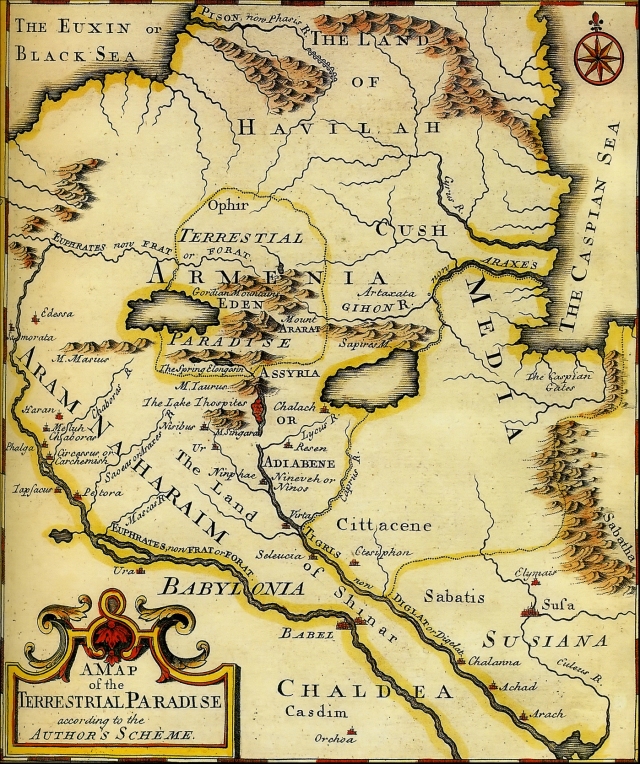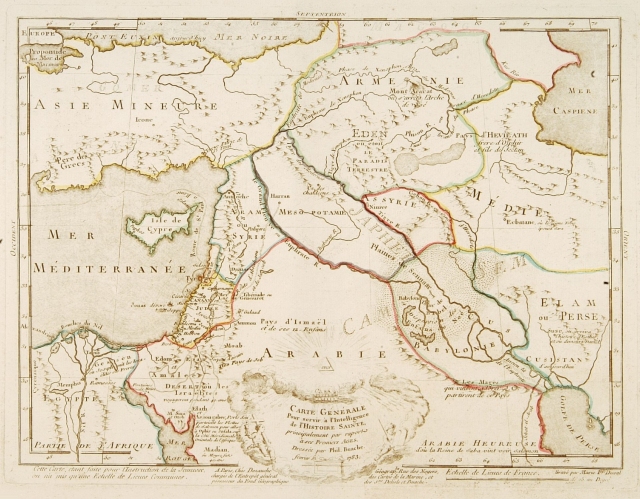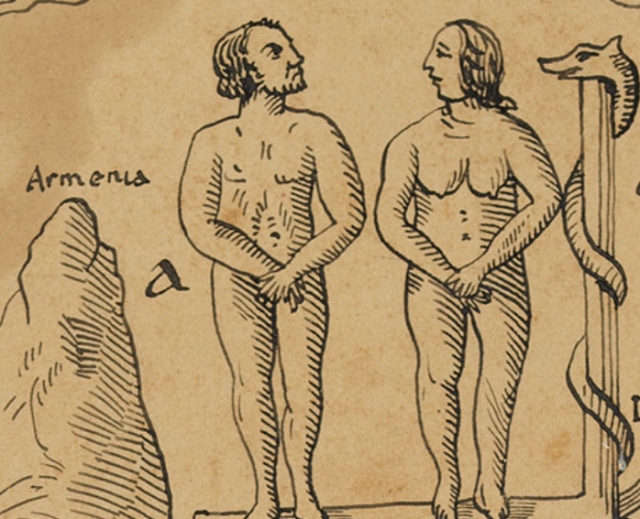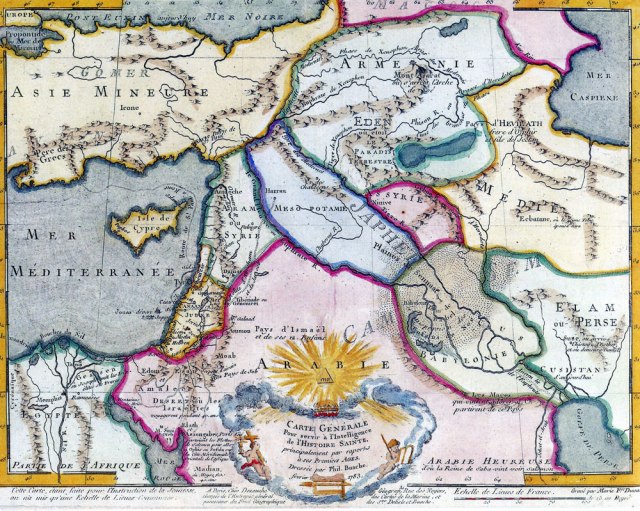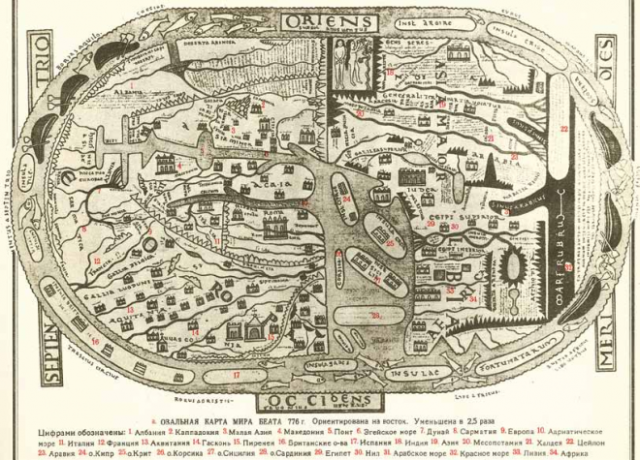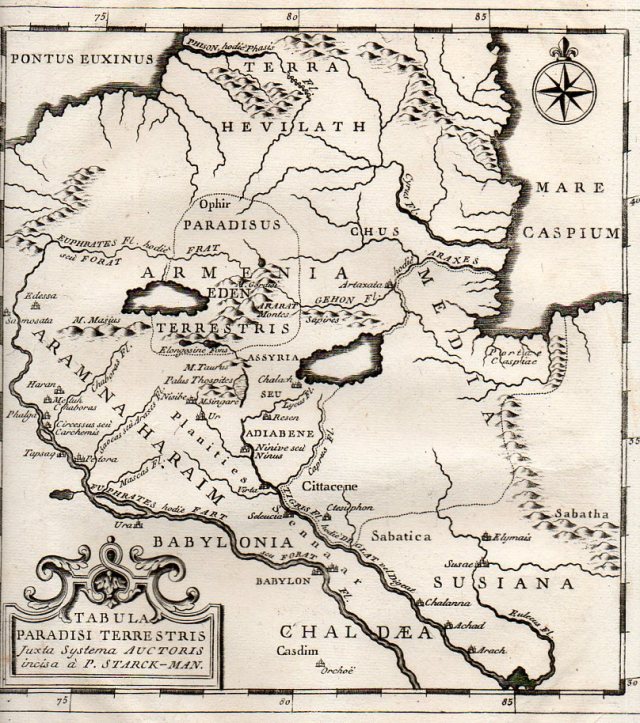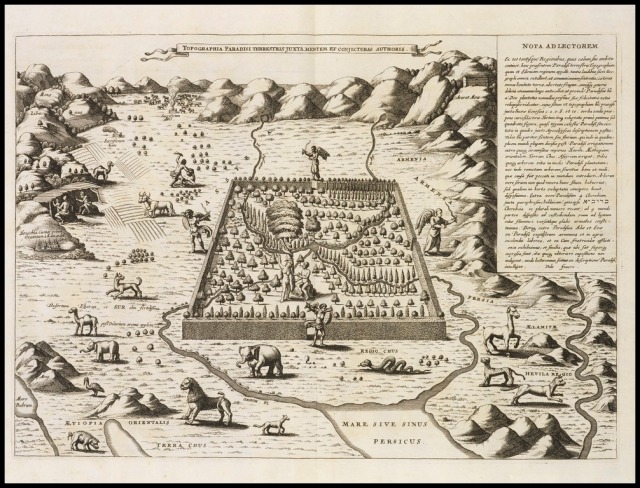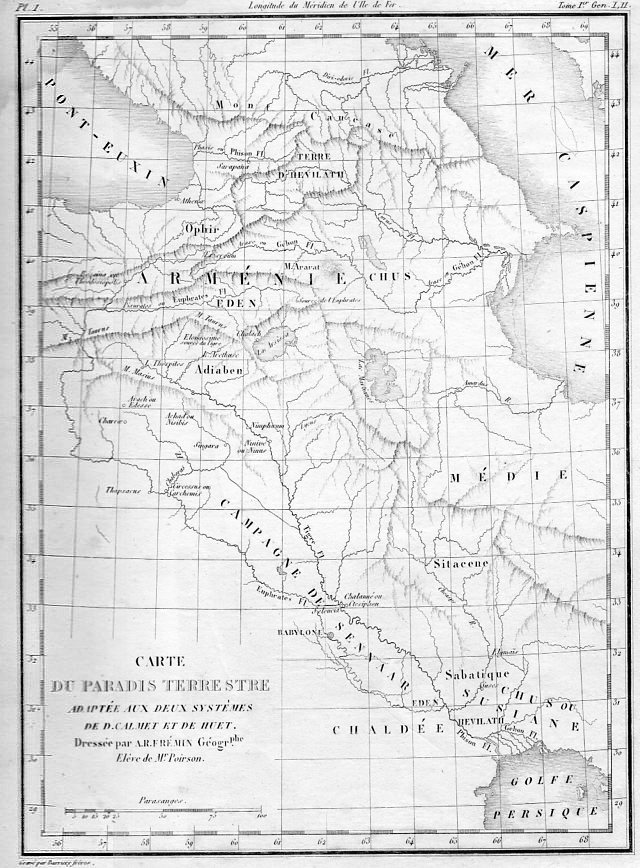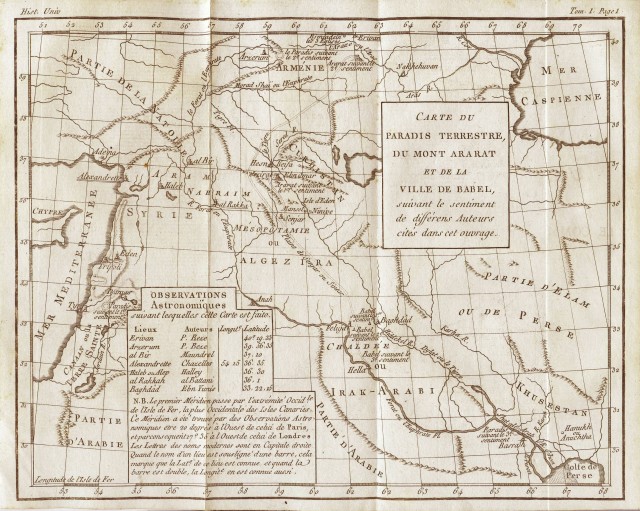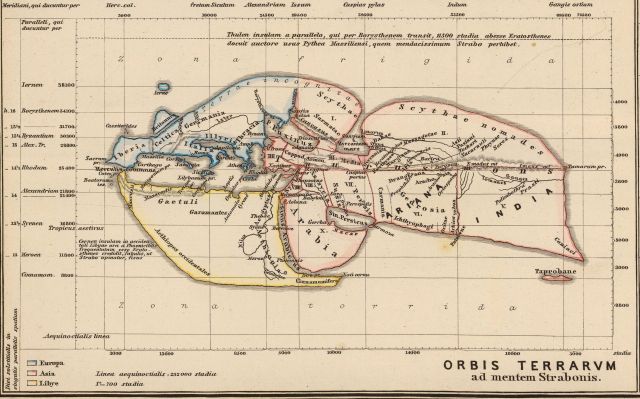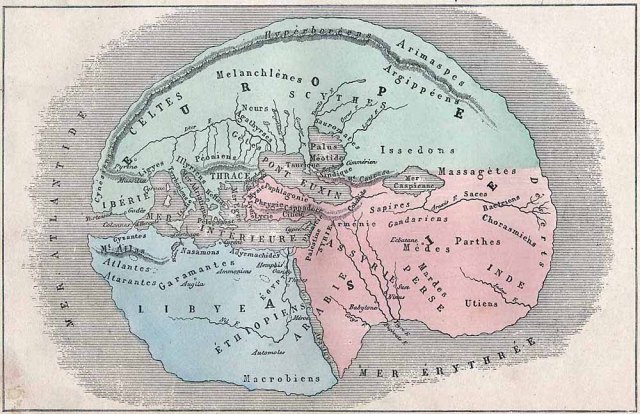Bellow the text that was used in the video including parts that didn’t made it into the video and a selection of maps of terrestrial Paradise:
The Biblical account of the garden of Eden has for long preoccupied the minds and imaginations of theologians, believers and countless adventurers of the past. Many have attempted to identify the location of the garden and put forward theories ranging from the underground, the north pole and even the surface of the moon. However if the location of the terrestrial paradise is to be understood according to scriptures, there is only one place that fits the description. That place is historic Armenia.
The Bible mentions a spring in the Garden which parts into four major rivers, including Tigris and the Euphrates. Tigris and Euphrates both have their headwaters in the area surrounding Mt. Ararat in historic Armenia. Many Biblical scholars have therefore placed the garden of Eden in Armenia. They have argued that posterity of Seth and Noah’s ark have remained close to Eden. Thus the birthplace of mankind is also the place of rebirth. These accounts are supported by ancient believes of the people of Mesopotamia, who often considered the Armenian Highlands to be the dwellings of the Gods (Cyclopædia of Biblical, Theological, and Ecclesiastical Literature, 1894).
In his memoirs Lord Byron writes:
“If the Scriptures are rightly understood, it was in Armenia that Paradise was placed. – Armenia, which has paid as dearly as the descendants of Adam for that fleeting participation of its soil in the happiness of him who was created from its dust. It was in Armenia that the flood first abated, and the dove alighted. But with the disappearance of Paradise itself may be dated almost the unhappiness of the country ; for though long a powerful kingdom, it was scarcely ever an independent one, and the satraps of Persia and the pachas of Turkey have alike desolated the region where God created man in his own image.” – Armenian exercises and poetry, 1886
- Lord Byron (1886) Armenian exercises and poetry
That Armenia was once considered the location of terrestrial Paradise can be attested from old maps and theological records. See blow for the maps.
Alessandro Scafi (2007) in his work “Finishing the unfinished: Paradise in Fausto da Longiano’s vernacular translation of Piccolomini’s Cosmographia (1544), describes Fausto and his thoughts on the location of terrestrial Eden. He writes:
“As a possible location, Fausto (1544) proposed Armenia, a region which in the sixteenth century included the area between the upper Euphrates and Lake Urmia, the Black Sea and the Syrian desert. The identity of two of the four rivers named in Genesis, the Tigris and the Euphrates, was uncontroversial, and both rivers were known to rise in Armenia. The more problematic Gihon and Pishon could be identified amongst the local rivers (for Fausto, the Araxes and the Cyrus).”
- Alessandro Scafi (2007), Finishing the unfinished: Paradise in Fausto da Longiano’s vernacular translation of Piccolomini’s Cosmographia (1544)
Joseph E. Duncan (1972) likewise recounts:
“Both Pererius and Lapide had suggested Armenia as logical location for Eden and paradise. Johann Vorstius, maintaining that Scripture clearly stated that the great river arose in Eden itself, also contended that Eden and paradise must be in Armenia.
One of the most complete of the earlier arguments for an Armenian paradise was offered by Carver in a tract publication in 1666… He found the site of Eden in Armenia Major, on the south side of Mount Taurus. He speculated that paradise might have been transformed into a nitrous lake which Pliny had said was located in this area.”
- Joseph E. Duncan (1972) Milton’s Earthly Paradise: A Historical Study of Eden, Univ Of Minnesota Press; Minnesota Archive Editions edition (July 6, 1972)
17th century French scholar Joseph Pitton de Tournefort writes:
“And if we may suppose the Terrestrial Paradise to have been a place of considerable extent, and to have retained some of its beauties, notwithstanding the alterations made in the Earth at the Flood, and since that time; I don’t know a finer spot to which to assign this wonderful place, than the Country of the Three-Churches (Echmiadzin-Armenia), about twenty French leagues distant from the Heads of Euphrates and Araxes, and near as many from the Phasis.” – A Voyage Into the Levant (1741)
In their Encyclopedia of Biblical, Theological, and Ecclesiastical literature (1894), John McClintock and James Strong recount nine principal theories of the proposed location of earthly paradise. Armenia is considered the most likely location of Eden.
“The opinion which fixes Eden in Armenia we have placed first, because it is that which has obtained most general support, and seems nearest the truth. (See No. vi.) For if we may suppose that, while Cain moved to the East (Gen. iv, IG), the posterity of Seth remained in the neighborhood of the primeval seat of mankind, and that Noah’s ark rested not very far from the place of his former abode, then Mount Ararat in Armenia becomes a connecting point between the antediluvian and post-diluvian worlds (Gen. viii, 4)”
Eden is shortly described as follows:
“Eden was a tract of country, and that in the most eligible part of it was the Paradise, the garden of all delights, in which the Creator was pleased to place his new and pre-eminent creature, with the inferior beings for his sustenance and solace.”
- John McClintock & James Strong (1894) Cyclopædia of Biblical, Theological, and Ecclesiastical Literature.
“As nearly as we can gather from the Scriptural description, Eden was a tract of country, the finest imaginable, laying probably between the 35th and the 40th degree of N. latitude, of such moderate elevation, and 80 adjusted, with respect to mountain ranges, and watersheds, and forests, as to preserve the most agreeable and salubrious conditions of temperature and all atmospheric changes. Its surface must therefore have been constantly diversified by hill and plain. In the finest part of this land of Eden, the Creator had formed an enclosure, probably by rocks, and forests, and rivers, and had filled it with every product of nature conducive to use and happiness. Due moisture, of both the ground and the air, was preserved by the streamlets from the nearest hills, and the rivulets from the more distant; and such streamlets and rivulets, collected according to the levels of the surrounding country (“it proceeded from Eden”) flowed off afterwards in four larger streams, each of which thus became the source of a great river.
Here, then, in the south of Armenia, after the explication we have given, it may seem the most suitable to look for the object of our exploration, the site of Paradise.”
- John McClintock & James Strong (1894) Cyclopædia of Biblical, Theological, and Ecclesiastical Literature.
That the Biblical rivers cannot be identified with Nile (as some would claim) is described as follows:
“That the Hiddekel (this name is said to be still in use among the tribes who live upon its banks—Col.Chesney, Erp. to Tigris and Euphrates, i, 13) is the Tigris, and the Phrath the Euphrates, has never been denied, except by those who assume that the whole narrative is a myth which originated elsewhere, and was adapted by the Hebrews to their own geographical notions. As the former is the name of the great river by which Daniel sat (Dan. x, 4), and the latter is the term uniformly applied to the Euphrates in the Old Testament, there seems no reason to suppose that the appellations in Gen. ii, 14 are to be understood in any other than the ordinary sense. One circumstance in the description is worthy of observation. Of the four rivers, one, the Euphrates, is mentioned by name only, as if that were sufficient to identify it. The other three are defined according to their geographical positions, and it is fair to conclude that they were therefore rivers with which the Hebrews were less intimately acquainted. If this be the case, it is scarcely possible to imagine that the Gihon, or, as some say, the Pison, is the Nile, for that must have been even more familiar to the Israelites than the Euphrates, and have stood as little in need of a definition.”
- John McClintock & James Strong (1894) Cyclopædia of Biblical, Theological, and Ecclesiastical Literature.
That Eden is described in a post-deluvian manner as opposed to the Lutherian idea of geography being altered due to the flood is explained as follows:
“Nor will it do to suppose that in former ages great changes had taken place, which have so disguised the rivers in question that their course, connection, and identity are not now traceable ; for two of the rivers, at least, remain to this day essentially the same as in all historic times, and the whole narrative of Moses is evidently adapted to the geography as it existed in his own day, being constantly couched in the present tense, and in terms of well-known reference as landmarks.
Luther, rejecting the forced interpretations on which the theories of his time were based, gave it as his opinion that the garden remained under the guardianship of angels till the time of the Deluge, and that its site was known to the descendants of Adam ; but that by the flood all traces of it were obliterated. But, as before remarked, the narrative is so worded as to convey the idea that the countries and rivers spoken of were still existing in the time of the historian. It has been suggested that the description of the garden of Eden is part of an inspired antediluvian document (Morren, Rosenmiiller’s Geogr. i, 92). The conjecture is beyond criticism ; it is equally incapable of proof or disproof, and has not much probability to recommend it. The effects of the flood in changing the face of countries, and altering the relations of land and water, are too little known at present to allow any inferences to be drawn from them.”
- John McClintock & James Strong (1894) Cyclopædia of Biblical, Theological, and Ecclesiastical Literature.
In his memoirs “Armenia, travels and studies” famous Brit H. F. B. Lynch writes:
“What attracted me to Armenia? One inducement was curiosity : what lay beyond those mountains, drawn in a wide half-circle along the margin of the Mesopotamian plains? The sources of the great rivers which carried me southwards, a lake with the dimensions of an inland sea, the mountain of the Ark, the fabled seat of Paradise.”
- Armenia, travels and studies H. F. B. Lynch (1901)
During her travels in Armenia, missionary Maria A. West wrote:
“This is the Christian Crusade of the nineteenth century ; far exceeding in moral sublimity that of the olden time, when the kings of the earth banded themselves together to rescue the Holy Land from the hand of the Turk ! How wonderful that the Great Commission, the Master s last Command, uttered in this very land, more than eighteen hundred years ago, should have been caught up, and re-echoed in the New World, by a nation not yet a century old ! That scores of its sons and daughters should carry the “ glad tidings” from the Caspian and Black Seas on the north, beyond the Mediterranean on the south : In the country of Eden, and Ararat, the cradle of the human race.”
- Maria a. West (1875), Romance of Missions: or, Inside Views of Life and Labor, Land of Ararat.
“A lovely lake, like that of Galilee, sleeps within their embrace; a branch of the Euphrates curves its gleaming arm around this wondrous mosaic of emerald and agate, carnelian and onyx, with the golden sunlight resting upon embowered villages, of which we count twenty-five without, and fifty with the aid of a glass, their beaten paths crossing and recrossing the plain, in every direction.
It may indeed have been, as the people say, “the very Garden of Eden” where Adam and Eve together watched the opening of blushing flowers and the ripening of luscious fruits, after the marriage ceremony “ the crowning” as the Orientals call it had been performed ; for, “in the day that God created man male and female created He them, and BLESSED THEM, and CALLED THEIR NAME ADAM.” Here, perhaps, they plucked and ate the forbidden fruit, whose prolific seeds have borne bitter harvest all over the face of the wide, wide world !”
- Maria a. West (1875), Romance of Missions: or, Inside Views of Life and Labor, Land of Ararat.
And this lost Paradise, so long trodden under foot by the Destroyer, “her hedges broken down, so that all they which pass by the way do pluck her, wasted by the boar out of the wood, and devoured by the wild beast of the field:” -This vineyard, planted “eastward” -by God s “right hand” -at the opening of man’s history – (“a river went out to water it;” and from thence it was parted and became four heads ; and the fourth river is “Euphrates:”) -This long-deserted Garden is to be “regained” for the “second Adam,” and made to “blossom as the rose;” to “ blossom abundantly, and rejoice even with joy and singing ; the glory of Lebanon shall be given unto it, the excellency of Carmel and Sharon ; and the REDEEMED shall walk there.”
- Maria a. West (1875), Romance of Missions: or, Inside Views of Life and Labor, Land of Ararat.
Our national birthday of freedom finds us on these distant heights in the land which was the cradle of the human race the land of Ararat, the country, if not the Garden of Eden, where we may suppose our first parents wandered after their expulsion from Paradise, and obtained their bread by the sweat of their brow. And we, their self-exiled children, are striving to undo the mischief which their disobedience brought on these fair plains, and among these smiling valleys and rugged mountains.
- Maria a. West (1875), Romance of Missions: or, Inside Views of Life and Labor, Land of Ararat.
The Armenian language belongs to the Indo-Germanic family, enriched with many Sanscrit words, but having no affinity to the Semitic, or any of the more modern tongues. The people claim that it was the language of paradise, and will be the language of the heavenly world.
- Maria a. West (1875), Romance of Missions: or, Inside Views of Life and Labor, Land of Ararat.
Selection of antique maps of terrestrial Paradise:
![A Map of the Terrestrial Paradise, Emmanuel Bowwen (1780)]()
A Map of the Terrestrial Paradise, Emmanuel Bowwen (1780)
![Fine map of the Middle East, including the Holy Land, Cyprus, Iran and Irak, etc. Philippe Buache was one of the most active proponents of the so-called "school of theoretical cartography" active in mid-18th century France. Published by Dezauche and engraved by Marie F. Duval.]()
Fine map of the Middle East, including the Holy Land, Cyprus, Iran and Irak, etc.
Philippe Buache was one of the most active proponents of the so-called “school of theoretical cartography” active in mid-18th century France. Published by Dezauche and engraved by Marie F. Duval.
![Paradis Terrestre by Desbrulins, F. 1700-1799 source Bibliothèque nationale de France]()
Paradis Terrestre by Desbrulins, F. 1700-1799 source Bibliothèque nationale de France
![Eden in Armenia 8th century world map from Turin]()
Eden in Armenia 8th century world map from Turin
![Eden in Armenia 8th century world map from Turin]()
Eden in Armenia 8th century world map from Turin
![A General Map for Information about the History of the Saints, Phillippe Buache, Published in 1783 in Paris.]()
A General Map for Information about the History of the Saints, Phillippe Buache, Published in 1783 in Paris.
![Map of the Earthly Paradise by Moyse, 1724 Source: Bibliothèque nationale de France]()
Map of the Earthly Paradise by Moyse, 1724 Source: Bibliothèque nationale de France
![Map of the Earthly Paradise by Moyse, 1724 Source: Bibliothèque nationale de France]()
Map of the Earthly Paradise by Moyse, 1724 Source: Bibliothèque nationale de France
![Antique map of the Paradise, Huet Stark-man, 1725 'Kaarte van Het Aardsche Paradys']()
Antique map of the Paradise, Huet Stark-man, 1725 ‘Kaarte van Het Aardsche Paradys’
![Athanasius Kircher, 1675 Topographia Paradisi terrestris juxta mentem et conjecturas]()
Athanasius Kircher, 1675 Topographia Paradisi terrestris juxta mentem et conjecturas
![L’Arménie, jardin d’Eden, page de l’Atlas de cartographie historique de l’Arménie, Jacques Khanzadian, copie de carte ancienne, 1675]()
L’Arménie, jardin d’Eden, page de l’Atlas de cartographie historique de l’Arménie, Jacques Khanzadian, copie de carte ancienne, 1675
![Map from the atlas Theatre of the World by Abraham Ortelius featuring Eden in Armenia. Antwerp, 1601]()
Map from the atlas Theatre of the World by Abraham Ortelius featuring Eden in Armenia. Antwerp, 1601
![Овальная карта мира Беата (776 г.) из «Атласа истории географических открытий и исследований». Москва, 1959]()
Овальная карта мира Беата (776 г.) из «Атласа истории географических открытий и исследований». Москва, 1959
![Увеличенный фрагмент той же карты, с подписью «Armenia regio».]()
Увеличенный фрагмент той же карты, с подписью «Armenia regio».
![The Manchester (a.k.a. Altamira) Beatus mappamundi, ca. 1175, John Rylands Library, MS. Lat. 8, fols. 43v-44, Manchester, England]()
The Manchester (a.k.a. Altamira) Beatus mappamundi, ca. 1175,
The Manchester (a.k.a. Altamira) Beatus mappamundi, ca. 1175, John Rylands Library, MS. Lat. 8, fols. 43v-44, Manchester, England
![The world map from the Saint-Sever Beatus painted c. 1050 A.D. as an illustration to Beatus's work at the Abbey of Saint-Sever in Aquitaine]()
The world map from the Saint-Sever Beatus painted c. 1050 A.D. as an illustration to Beatus’s work at the Abbey of Saint-Sever in Aquitaine
![Carte Du Paradis Terrestre Suivant le Systeme de l Auteur et Execute par P. Starck-man]()
Carte Du Paradis Terrestre Suivant le Systeme de l Auteur et Execute par P. Starck-man
![The map Tabula Paradisi Terrestris justa Systema Auctoris incisa a P. Stark-Man was printed late in the 18th century, probably around 1775..]()
The map Tabula Paradisi Terrestris justa Systema Auctoris incisa a P. Stark-Man was printed late in the 18th century, probably around 1775.
![Topographia Paradisi terrestris juxta mentem et conjecturas authoris, Kircher, Athanasius 1675]()
Topographia Paradisi terrestris juxta mentem et conjecturas authoris, Kircher, Athanasius 1675
![Antique map of the Garden of Eden by Calmet - 1789]()
Antique map of the Garden of Eden by Calmet – 1789
![Moxon's Paradise of the Garden of Eden with the Countries circumjacent inhabited by the Patriarchs, printed in 1690]()
Moxon’s Paradise of the Garden of Eden with the Countries circumjacent inhabited by the Patriarchs, printed in 1690
![The Terrestrial Paradise (c.1780) by Louis Brion de la Tour from the 'Histoire Universelle depuis le Commencement du Monde']()
The Terrestrial Paradise (c.1780) by Louis Brion de la Tour from the ‘Histoire Universelle depuis le Commencement du Monde’
![Ecclesiastical map of the first ages of the world, by S. Robert Vangondy 1762]()
Ecclesiastical map of the first ages of the world, by S. Robert Vangondy 1762
![Ancient Armenian drawing of what resembles the story of Adam and Eve.]()
Ancient Armenian drawing of what resembles the story of Adam and Eve.
![]()
![]()














































































































